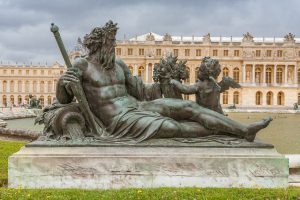| Palace of Versailles, a place of great history |
The Palace of Versailles is considered as one of the biggest palaces in the world. Its origins are back to 1629. It was first a hunting relay for the King Louis XIII, father of Louis XIV, but also a place of power for the Royal family with Louis XIV and from the nineteenth century a museum after the Revolution. 10 000 people used to work and serve the royal family during the French monarchy. Composed of the castle, the gardens, the park, the estate of the Trianon and some outbuildings in the city, the estate of Versailles now covers more than 800 hectares.
The castle of Versailles
Classified since 1979 in the UNESCO World Heritage Site, the Palace of Versailles is a brilliant achievement of French art in the seventeenth century. Located south-west of Paris, this castle and its estate aimed to glorify the French monarchy. The former hunting lodge of Louis XIII was transformed and expanded by his son Louis XIV who installed his court and his government in 1682.
The first phase of the expansion (1661–1678) was designed and supervised by the architect Louis Le Vau. The interior decoration was assigned to Charles Le Brun. The King ordered a further enlargement, which he entrusted to the young architect Jules Hardouin-Mansart. Louis XIV instructed Mansart to begin the construction of the Royal Chapel of Versailles. Mansart also replaced Le Vau’s large terrace, facing the garden on the west, becoming the most famous room of the palace, the Hall of Mirrors. Until the French Revolution, kings have succeeded embellishing the castle, each to their own. Louis XV added the royal opera. The Emperor Napoleon adjusted the Trianon after Queen Marie-Antoinette.
Overall, the Château now has 2,300 rooms spread over 63,154 m2. Covered by around a million square feet (10 hectares) of roof, the palace of Versailles has 2,143 windows, 1,252 chimneys, and 67 staircases. It is mostly divided by the private apartments of the King and the private apartments of the Queen, with other major parts such as the Hall of Mirrors, salons, the Royal chapel, the Royal opera, the museum and so forth.

Palace of Versailles Gardens and Park
From the central window of the Hall of Mirrors, the eye of the visitors has a great perspective. Indeed, it leads to the parterres d’eau two huge bodies of water, the gardens and the park. André Le Nôtre was pleased to develop this original East-West axis, prior to the reign of Louis XIV, and extend it by widening the royal alley and digging the Grand Canal .
Beyond the gardens extends the Park which leads naturally to the Grand Canal, shaped as a cross. Among the 386 works of art in the gardens, including 221 statues, Apollo god of the sun occupies a major place. He is represented seven times at various places in the park. The idealized image of the Sun King is the most dazzling in the basin bearing his name, overlooking the Grand Canal.
Discover the immense complex of parks :
- The Orangerie
- Gardens
- Groves
- Caves
- Fountains
The park of Versailles is considered as the model of the regular garden “à la Française”, decorated with marble, bronze or lead statues, and ponds animated by water games and where the myth of Apollo is always present. André Le Nôtre was gardener of King Louis XIV from 1645 to 1700 and intended for the development of the park and gardens of the Palace of Vaux-le-Vicomte and Chantilly as well. King of the gardeners and gardener of the king, Le Nôtre gave his letters of nobility to the garden “à la française”.

The estate of Trianon away from the Palace of Versailles
Not too far from the Palace of Versailles, Louis XIV gave free rein to his love of architecture and gardens. This is why he created a domain reserved for his personal use. Arranged on the site of an old village, the places naturally preserved the name: Trianon. King Louis XV extended the Grand Trianon with the petit Trianon. He placed his favorite Madame de Pompadour there.
Queen Marie-Antoinette fell in love with the place and contributed to its development and beautification. She develops the gardens of Trianon in two distinct phases. The first, from 1777, corresponds to the creation of the English Garden. In a second time, in 1783, she asked Richard Mique to extend the garden to the north by building a village around a new lake. The work began in the summer of 1783 and ended in 1786. The style of the Queen hamlet is not clearly identifiable. Indeed, it is a mixture of varied rural architectures, but gives off an undeniable lovely unity. There, her children grew up surrounded by animals of the farm, in the style of Normandy.
You may prepare a visit of Versailles, with care. Then, you will not miss the Beauty of this French Icon.
Emy,


